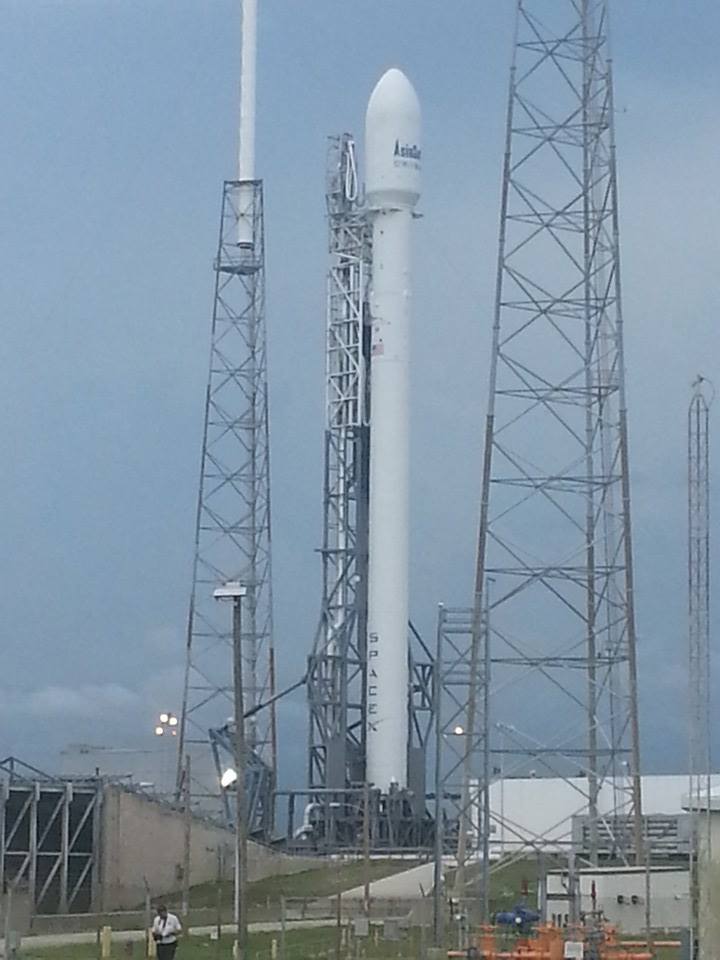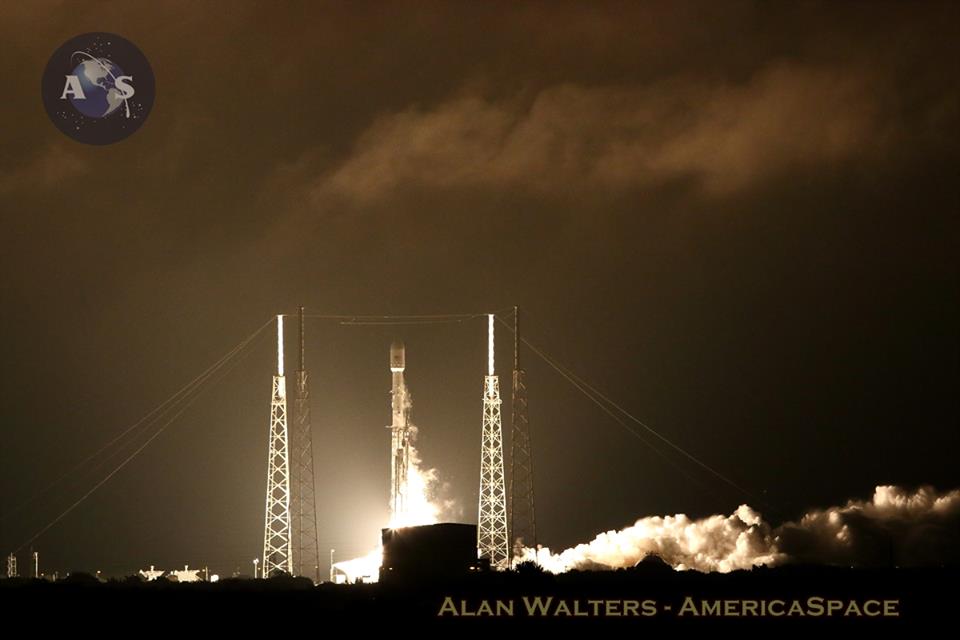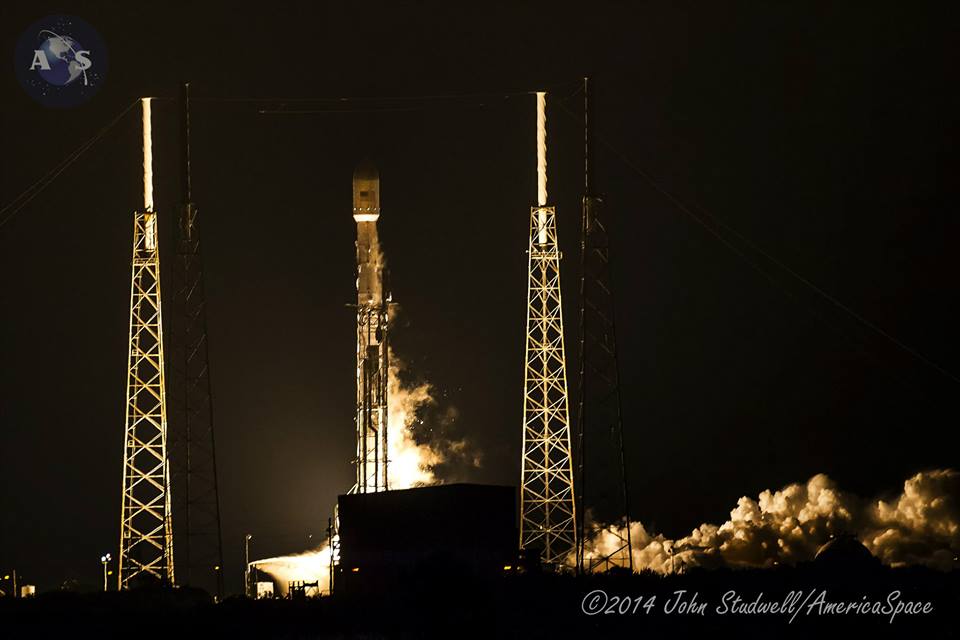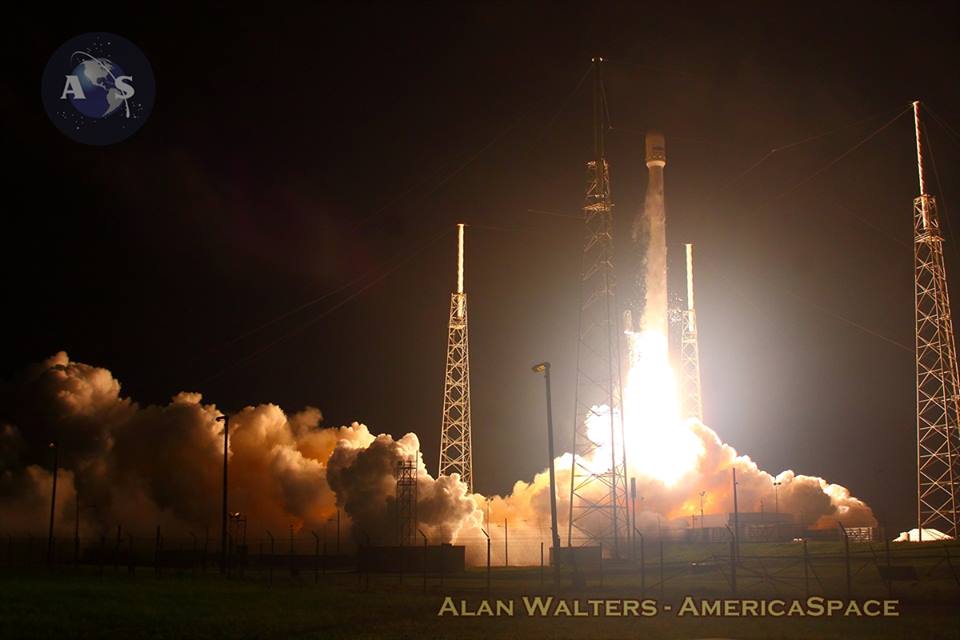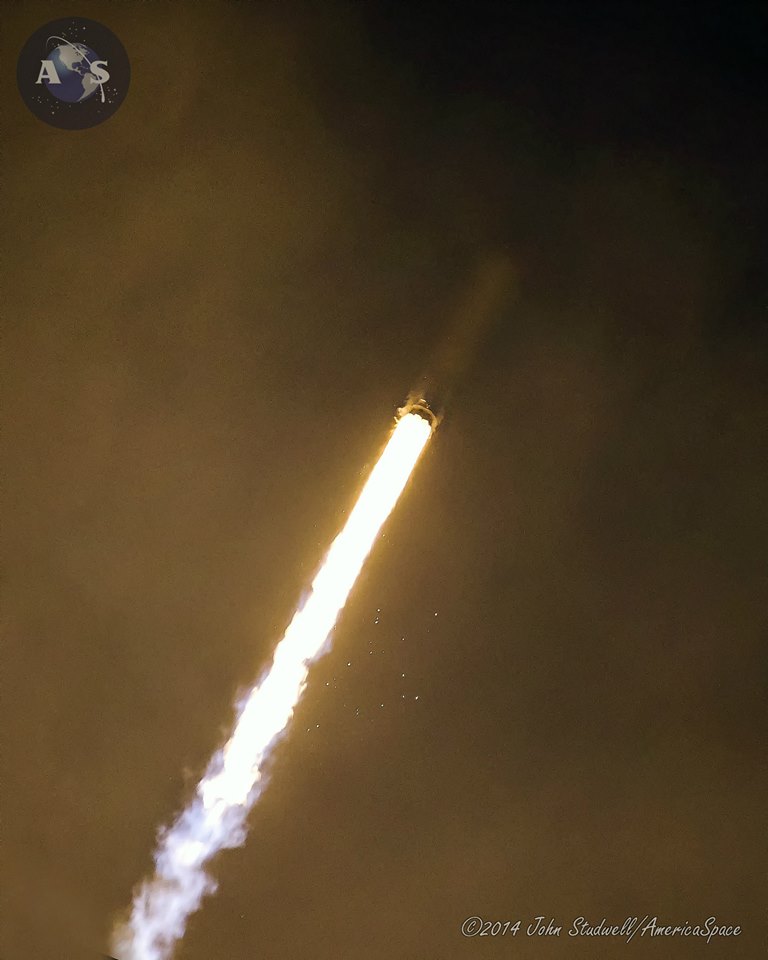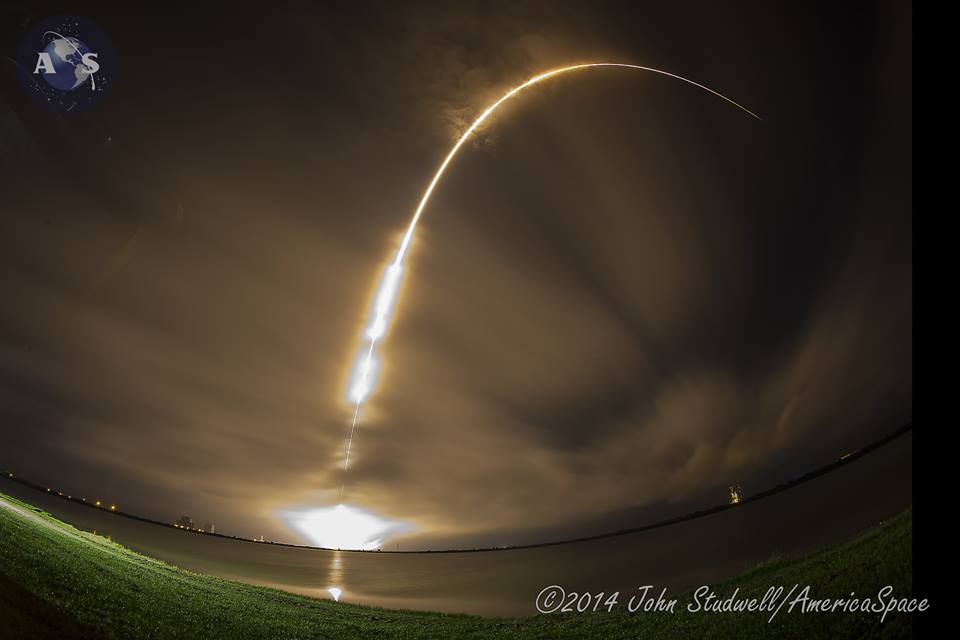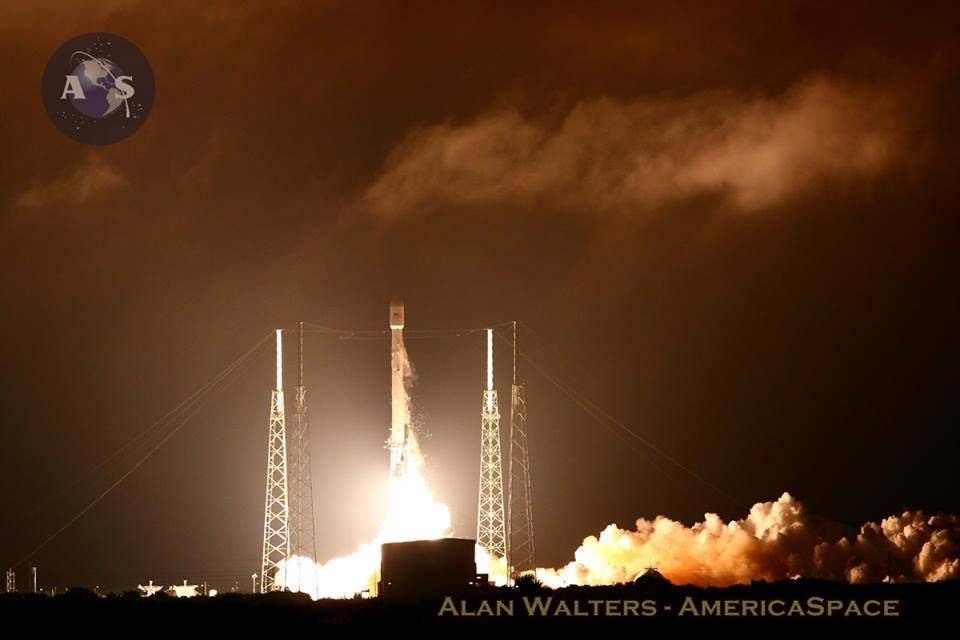
In spite of a nail-biting scrub in the final seconds, and ultimately erroneous rumors of a 24-hour delay, SpaceX successfully launched a record-setting fourth mission of 2014 at 4:00 a.m. EDT Tuesday, 5 August, delivering the powerful AsiaSat-8 communications satellite into geostationary transfer orbit at an altitude of 22,300 miles (35,900 km). As well as representing SpaceX’s third foray to geostationary altitude—following the SES-8 mission in December 2013 and the Thaicom-6 mission in January 2014—today’s flight also achieves two “personal bests” for the Hawthorne, Calif.-based launch services provider: a record-breaking fourth launch within a single calendar year and two back-to-back launches within just 22 days of one another. With the successful delivery of AsiaSat-8, SpaceX can at last leave several months of frustrating delays in the past and focus on with ambitious plans to launch AsiaSat-6 in late August and another Dragon cargo mission (SpX-4) to the International Space Station (ISS) in mid-September.
As described in AmericaSpace’s AsiaSat-8 preview article, the two-stage Falcon 9 v1.1 rocket—making its sixth flight in just ten months—was transferred to Space Launch Complex (SLC)-40 at Cape Canaveral Air Force Station, Fla., on Thursday, 31 July, minus its payload fairing, to support a static test firing of the nine Merlin-1D first stage engines. Upon successful completion of this pre-launch protocol, the vehicle was returned to a horizontal configuration and taken back to its integration building, where AsiaSat-8 and its bulbous payload fairing were installed. The complete stack was then rolled out to SLC-40 on Monday, ahead of an opening launch attempt at 1:25 a.m. EDT Tuesday. The expansive window lasted for two hours and 46 minutes, closing at 4:11 a.m., and past experience indicated that SpaceX would utilize its entire time span, if needed.
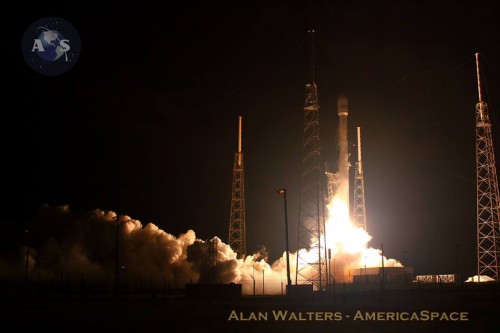
Since the heavyweight AsiaSat-8 payload required a geostationary transfer orbit, the mission demanded the maximum performance capability of the Falcon 9 v1.1 rocket, and, consequently, it was noted that a “propulsive return-over-water” and controlled splashdown of the first stage on extendible landing legs would not be attempted. With weather conditions for the small hours of Tuesday morning described by Patrick Air Force Base meteorologists as 70 percent favorable, the process of fueling the vehicle with liquid oxygen and a highly refined form of rocket-grade kerosene (known as “RP-1”) got underway at about 9:15 p.m. Monday. The “cryogenic” nature of the oxygen—whose liquid state exists within a temperature range from -221.54 degrees Celsius (-368.77 degrees Fahrenheit) to -182.96 degrees Celsius (-297.33 degrees Fahrenheit)—required the fuel lines of the Merlin-1D engines to be chilled down, in order to avoid thermally shocking and fracturing them. By 10:10 p.m., all propellants were fully loaded.
Three hours later, at 1:12 a.m. Tuesday, the countdown reached its final “Go-No Go” polling point of all stations at T-13 minutes. Passing smoothly through the polls, the “Terminal Countdown” got underway at T-10 minutes. During this period, the Merlin-1D engines were chilled, preparatory to their ignition sequence, and at 1:18 a.m. AsiaSat-8 was transferred to internal power and the Falcon 9 v1.1 itself transitioned to internal batteries. All external power utilities from the Ground Support Equipment (GSE) were disconnected, and at 1:20 a.m. the approximately 90-second process of retracting the launch pad’s “strongback” away from the vehicle got underway. The Flight Termination System (FTS)—tasked with destroying the rocket in the event of a major accident during ascent—was placed onto internal power and armed.
By T-2 minutes and 15 seconds, the first stage tanks had reached flight pressure. The Merlin-1D engines were purged with gaseous nitrogen and, at T-60 seconds, SLC-40’s “Niagara” deluge system of 53 nozzles was activated, flooding the pad surface and flame trench with 30,000 gallons (113,500 liters) of water, per minute, to suppress acoustic waves radiating from the engine exhausts. At T-45 seconds, all tanks on the first and second stages were to be confirmed at Flight Pressure and, as circumstances transpired, it was at around this point that the first call of “Hold! Hold! Hold!” was heard on the flight loop.

Nevertheless, the clock continued counting down to T-12 seconds, at which point it was manually halted. Shortly afterward, it was recycled to the T-13 minutes polling hold point and by 1:36 a.m.—about 11 minutes into the launch window—the Falcon 9 v1.1 was declared as having been “safed,” with both first and second stages returned to external power, the fuel tanks vented and liquid oxygen status restored to “Replenishment Mode.” At this stage, in spite of the lengthy period remaining in the window, speculation was rife that the launch attempt had been scrubbed and postponed by 24 hours. This speculation turned out to be erroneous, when SpaceX announced at 2:15 a.m. that a second attempt to get the AsiaSat-8 mission into orbit would be made before the closure of the window at 4:11 a.m.
In the adrenaline-charged minutes which followed, it became clear through a slow trickle of information from SpaceX that the hold had been first called at T-45 seconds, due to “an issue” with the first stage, and by 2:25 a.m. the clock had been recycled to T-20 minutes and holding. It remained that way for the better part of an hour, with all eyes and minds keenly focused on the need to resume counting no later than 3:51 a.m., in order to achieve a liftoff before the window ended. Finally at 3:22 a.m., a revised T-0 of 4:00 a.m. was authorized and the clock began counting again.
“Computers detected an off-nominal parameter related to the hydraulic system on the first stage that tripped a Red Line Limit and caused the automatic countdown abort,” Spaceflight101 reported later in the morning. “Teams then reviewed data and came to the conclusion that the parameter was slightly out-of-family, but not an indication of any problem with the hardware. Engineers took their time to review the telemetry and also perform testing of the first stage hydraulic system to confirm that no problems were present.”
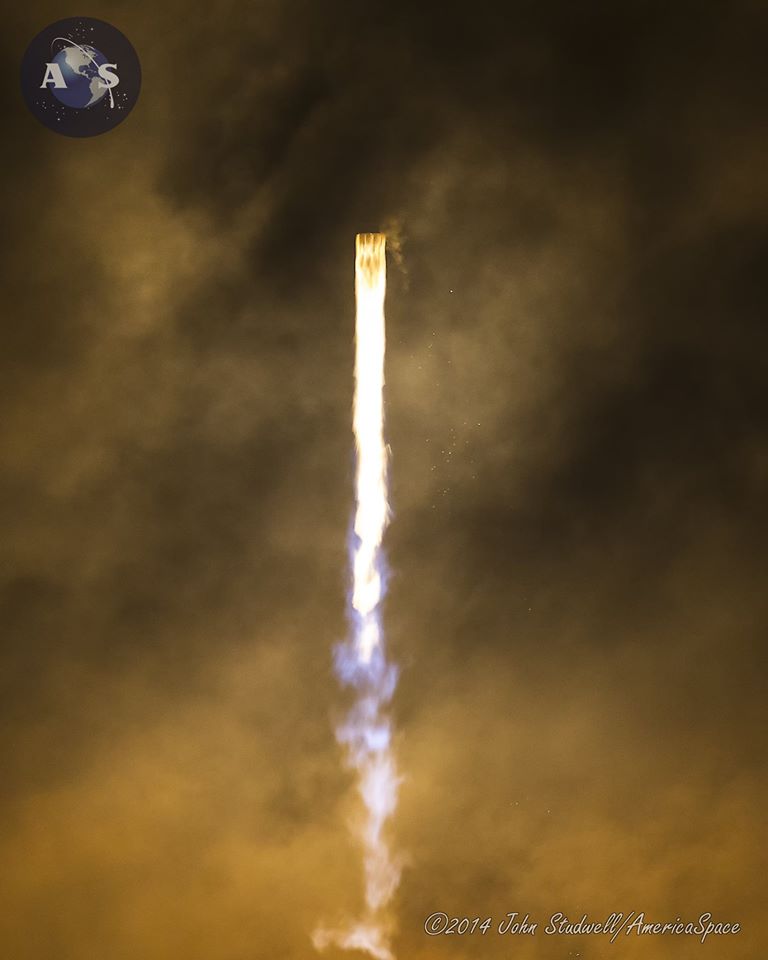
For the second time in a little over two hours, the final milestones were repeated. At 3:47 a.m., the “Go-No Go” poll at T-13 minutes produced a unanimous “Go for Launch” and the Launch Director pressed for the second time into the Terminal Countdown at T-10 minutes. Again, the nine Merlin-1D engines—configured with a singular center engine, surrounded by a circle of eight others—were chilled down, ready to accept the flow of cryogenic propellants, and both AsiaSat-8 and the Falcon 9 v1.1 were disconnected from GSE utilities and placed onto internal power. Again, the strongback was pulled away from the vehicle and had reached its fully retracted position by 3:56 a.m. Again, the FTS was armed, again the final topping of liquid oxygen was terminated and again the propellant tanks were pressurized for flight.
At 3:58 a.m., with two minutes remaining on the clock, the Merlin-1D engines were purged with gaseous nitrogen, and at T-60 seconds the nozzles of the Niagara system opened to deliver their flood of sound-suppressing water. This time, however, that final minute passed smoothly and without issue. At T-3 seconds, the nine engines roared to life, ramping up to a combined thrust of 1.3 million pounds (590,000 kg). Their initial health was verified to be satisfactory, and at precisely 4:00 a.m. EDT on Tuesday, 5 August, the fourth Falcon 9 v1.1 mission of 2014 turned night into day across the marshy Florida landscape.
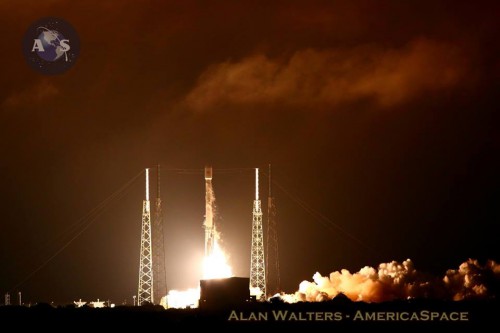
Immediately after clearing the SLC-40 tower, the rocket executed a combined pitch, roll, and yaw program maneuver to establish itself onto the proper flight azimuth to inject AsiaSat-8 into geostationary transfer orbit. Eighty seconds into the ascent, the vehicle exceeded the speed of sound and experienced a period of maximum aerodynamic stress (colloquially known as “Max Q”) upon its airframe. At about the same time, the Merlin-1D Vacuum engine of the second stage underwent its own chilldown process, ahead of its own ignition later in the ascent phase. At 4:02 a.m., 130 seconds after liftoff, two of the first-stage engines throttled back, under computer command, in order to reduce the rate of acceleration at the point of Main Engine Cutoff (MECO).
Finally, at 4:02:41 a.m., the seven remaining first-stage engines shut down and the lower component of the Falcon 9 v1.1 separated from the rapidly ascending stack. The turn then came for the restartable second stage, whose single Merlin-1D Vacuum engine—with a maximum thrust of 180,000 pounds (81,600 kg)—ignited at 4:02:49 a.m. to continue the boost to deliver AsiaSat-8 successfully into orbit. Thirty seconds into its burn, the 43-foot-tall (13.1-meter) payload fairing was jettisoned, exposing the satellite to the space environment for the first time. Finally, the Merlin-1D Vacuum shut down at 4:09:35 a.m., after which the stack coasted for 17 minutes, prior to a restart at 4:26 a.m. AsiaSat-8 was released from the second stage into free flight a few minutes later at 4:32 a.m.
Built by Space Systems/Loral (SS/L), the cube-shaped satellite has a payload power of 8,500 watts and represents the largest and most powerful AsiaSat ever inserted into orbit. It continues a quarter-century legacy of geostationary communications capability and will cover China, India, the Middle East, and a broad expanse of South-East Asia. Following initial checkout, AsiaSat-8 will be co-located with its sister satellite, AsiaSat-7—lofted atop a Proton-M/Briz-M booster from Baikonur Cosmodrome in Kazakhstan, back in November 2011—at 105.5 degrees East longitude. It will be operated by the Asia Satellite Telecommunications Company Ltd., headquartered in Hong Kong, and is equipped with 24 high-powered Ku-band transponders and a Ka-band regional beam payload. The high power of these transponders will enable the use of small-size receiving antennas on the ground. AsiaSat-8 is expected to provide exceptional power and inter-beam switching capabilities for a variety of users, including Direct-to-Home (DTH) television, private networks, and broadband.
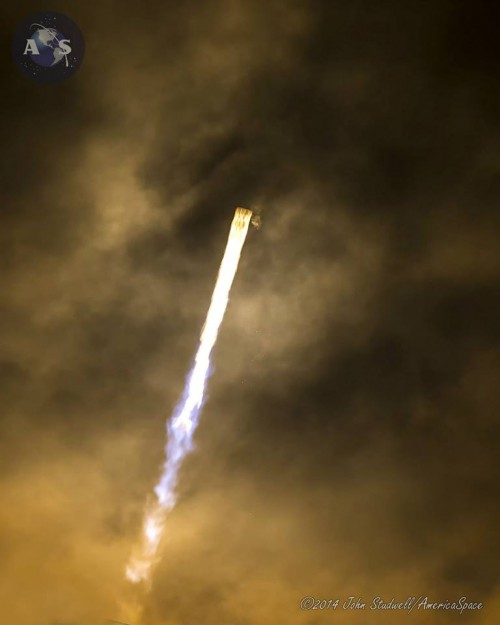
AsiaSat selected Space Systems/Loral (SS/L) in November 2011 to build its AsiaSat-8 and AsiaSat-6 platforms, both of which are expected to support 15-year operational lifetimes. Based upon the LS-1300 “bus,” with a pair of deployable solar arrays and batteries, both satellites breezed through thermal vacuum tests last December and underwent dynamic tests and Compact Antenna Test Range (CATR) tests in January-February 2014. The latter allowed engineers to measure antenna and payload performance and demonstrate their compliance with spacecraft specifications. “These critical tests are essential,” AsiaSat reported in December 2013, “in order to achieve the highest quality and reliability of the spacecraft before shipment to the SpaceX launch pad at Cape Canaveral.”
AsiaSat-8 was delivered to the Cape earlier this summer, and its arrival was featured on the Reuters sign in New York City’s Times Square on 4 July, allowing it to reach a daily audience of 1.5 million people. Following extensive tests, the satellite was encapsulated within its bulbous Falcon 9 v1.1 payload fairing on Tuesday, 29 July. The size and mass of the satellite demanded a 17.1-foot-diameter (5.2-meter) fairing, which stands about 43 feet (13.1 meters) tall.
The arrival of AsiaSat-8 will mark the ninth in a series of satellites, which can trace its ancestry back almost a quarter-century. AsiaSat-1, launched atop a Chinese Long March-3 booster in April 1990, had an interesting back story, for it was originally the Westar VI communications satellite, delivered into an improper orbit by shuttle mission 41B in February 1984 and triumphantly retrieved and returned to Earth by the 51A crew the following November. AsiaSat-2 followed in November 1995, also aboard a Long March rocket, after which the third (AsiaSat-3) and fourth (AsiaSat-3S) satellites in the series were delivered by Russian Proton-K boosters in December 1997 and March 1999. The latter replaced the decommissioned AsiaSat-1 from May 1999 and is today the oldest member of the fleet still in operational status. Kicking off the 21st century, AsiaSat-4 rode an Atlas IIIB from Cape Canaveral in April 2003, followed by AsiaSat-5 atop a Proton-M/Briz-M from Baikonur in August 2009 and the most recent additional, AsiaSat-7, in November 2011.
AsiaSat-5 entered the headlines in the summer of 2014, during the World Cup coverage from Brazil, when it delivered the first-ever live telecast of the international football competition in 4K resolution. Commonly (though not strictly accurately) known to the general consumer as “ultra-high-definition television” (UHDTV), 4K produces horizontal resolution of close to 4,000 pixels, more than four times higher than standard HDTV and capable of 60 frames per second. AsiaSat-5 delivered live 4K coverage of the Colombia-Uruguay Round of 16 match on 28 June, followed by the Germany-France quarter-final on 4 July and the final, between Germany and Argentina, on 13 July. According to AsiaSat, the worldwide number of 4K television households is expected to rise from 2.2 million at the end of 2013 to as high as 66.2 million by the end of 2018. Moreover, the Asia-Pacific region is forecasted to become the single largest 4K television market by 2016, accounting for 42 percent of global 4K television households.
Want to keep up-to-date with all things space? Be sure to “Like” AmericaSpace on Facebook and follow us on Twitter: @AmericaSpace
BELOW: Photos from our coverage of the SpaceX AsiaSat-8 launch. All images credit Alan Walters and John Studwell for AmericaSpace. Images copyright 2014, all rights reserved, unauthorized use is prohibited.
